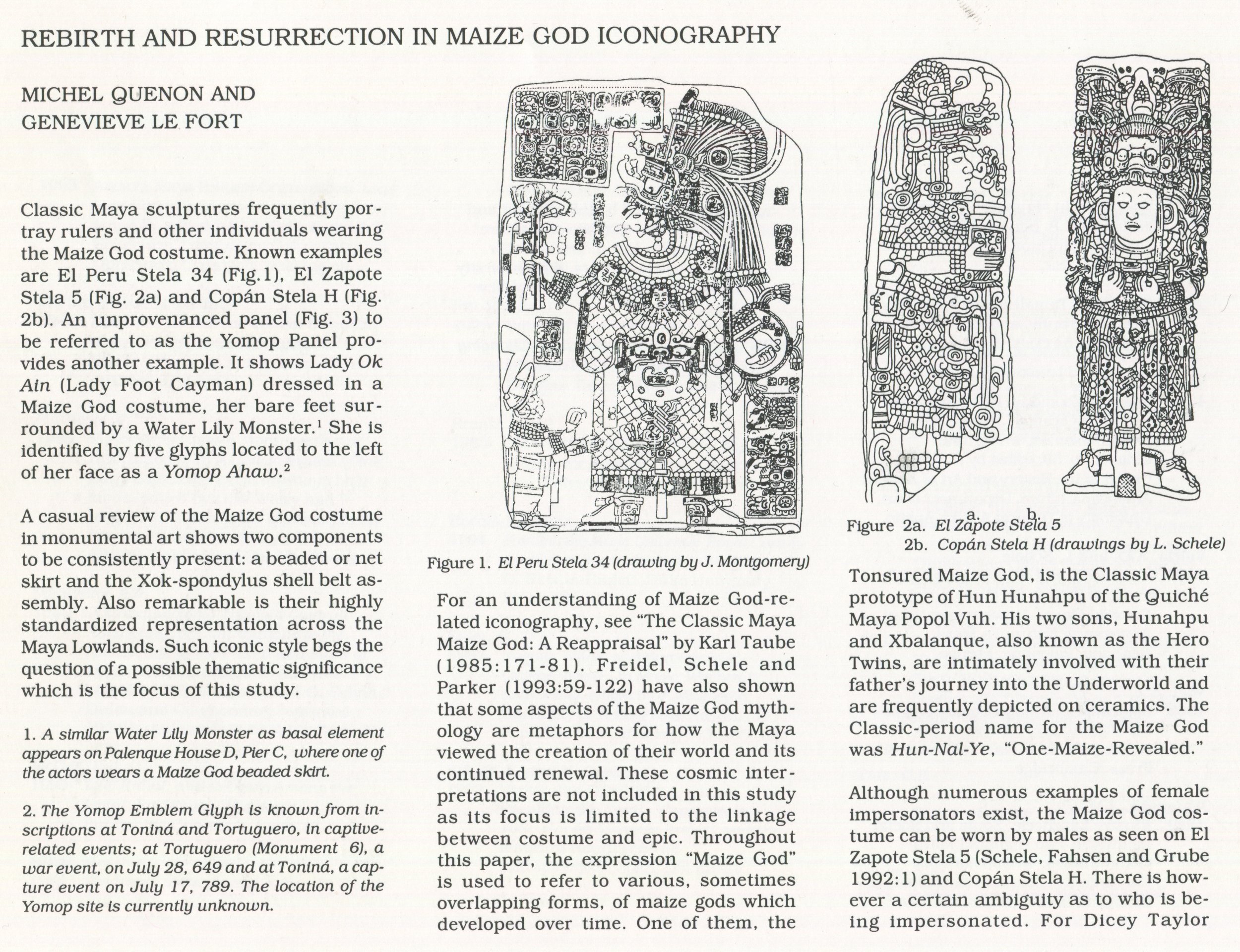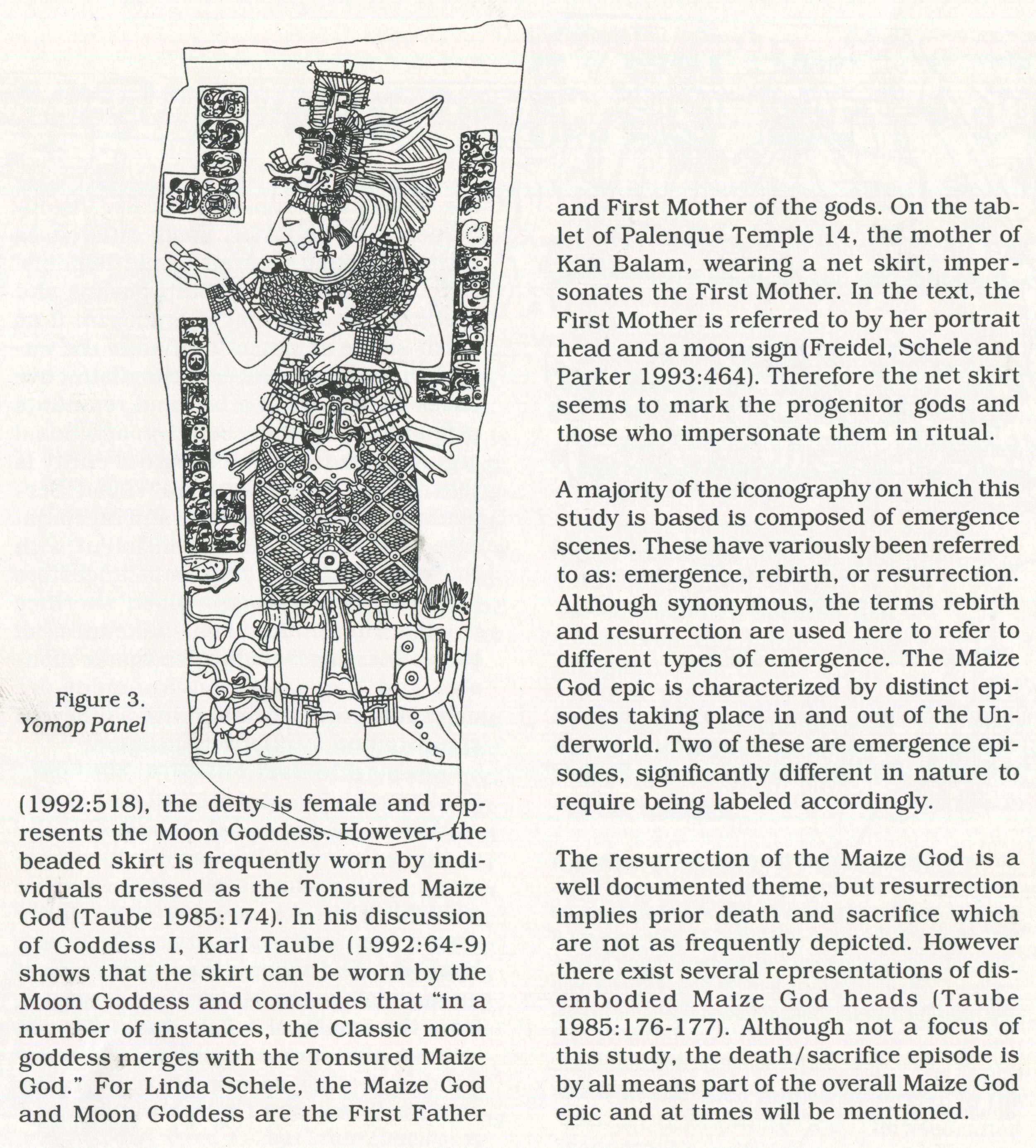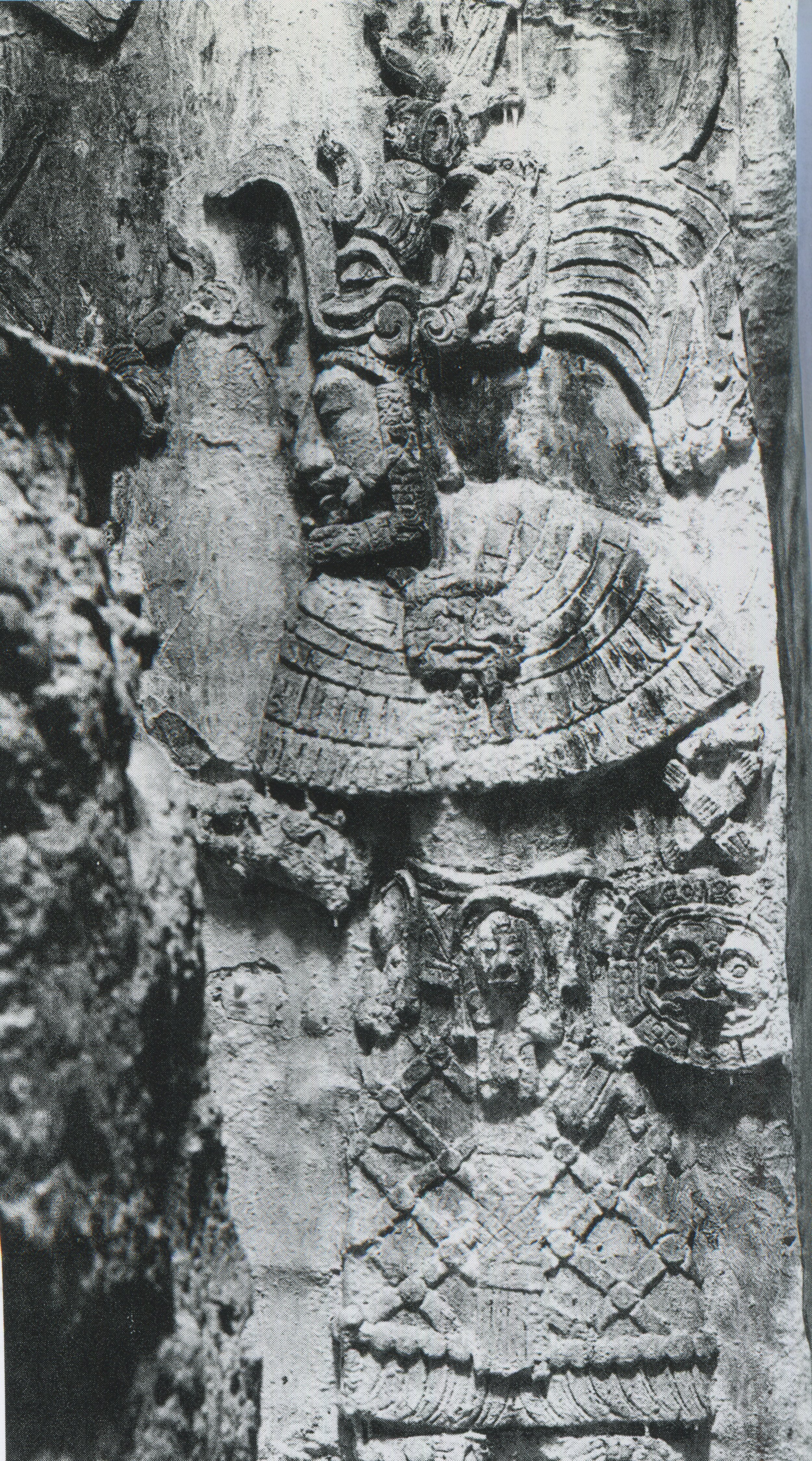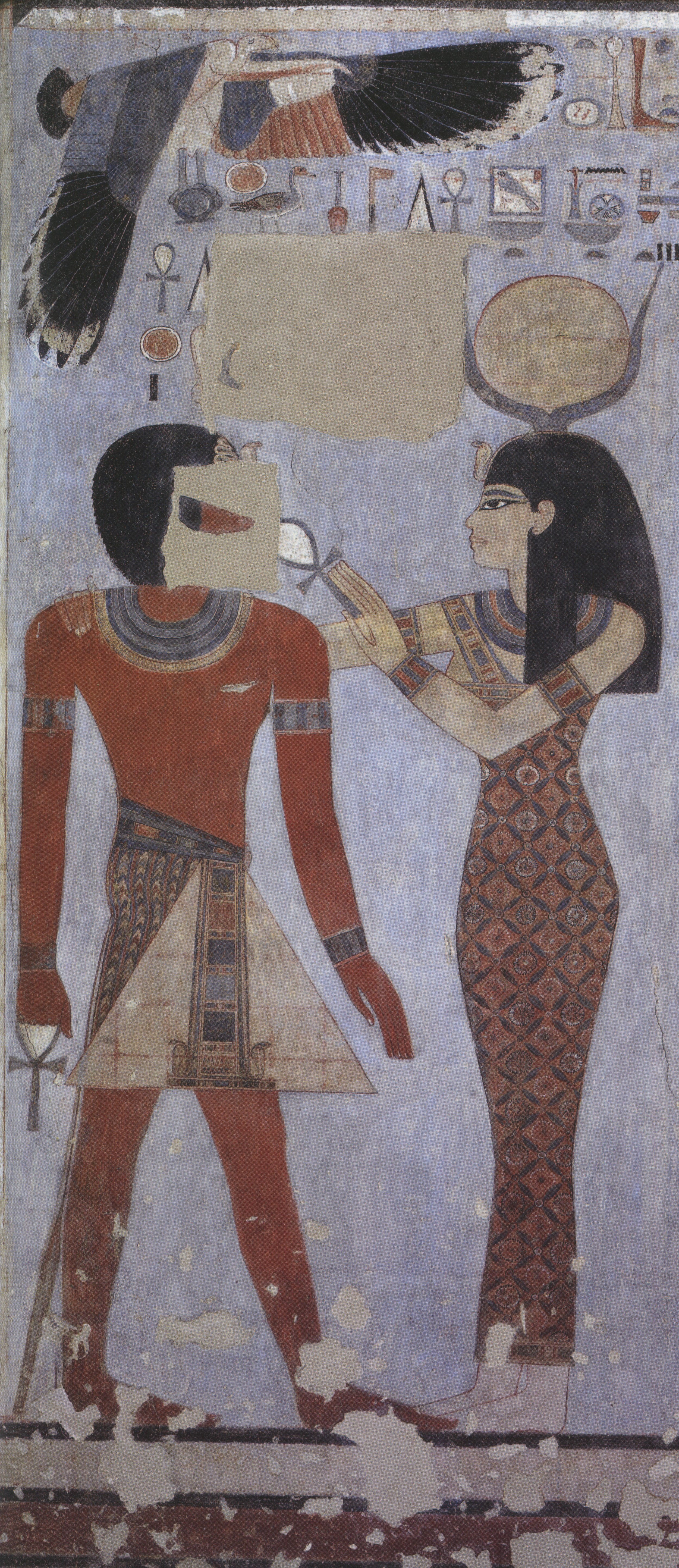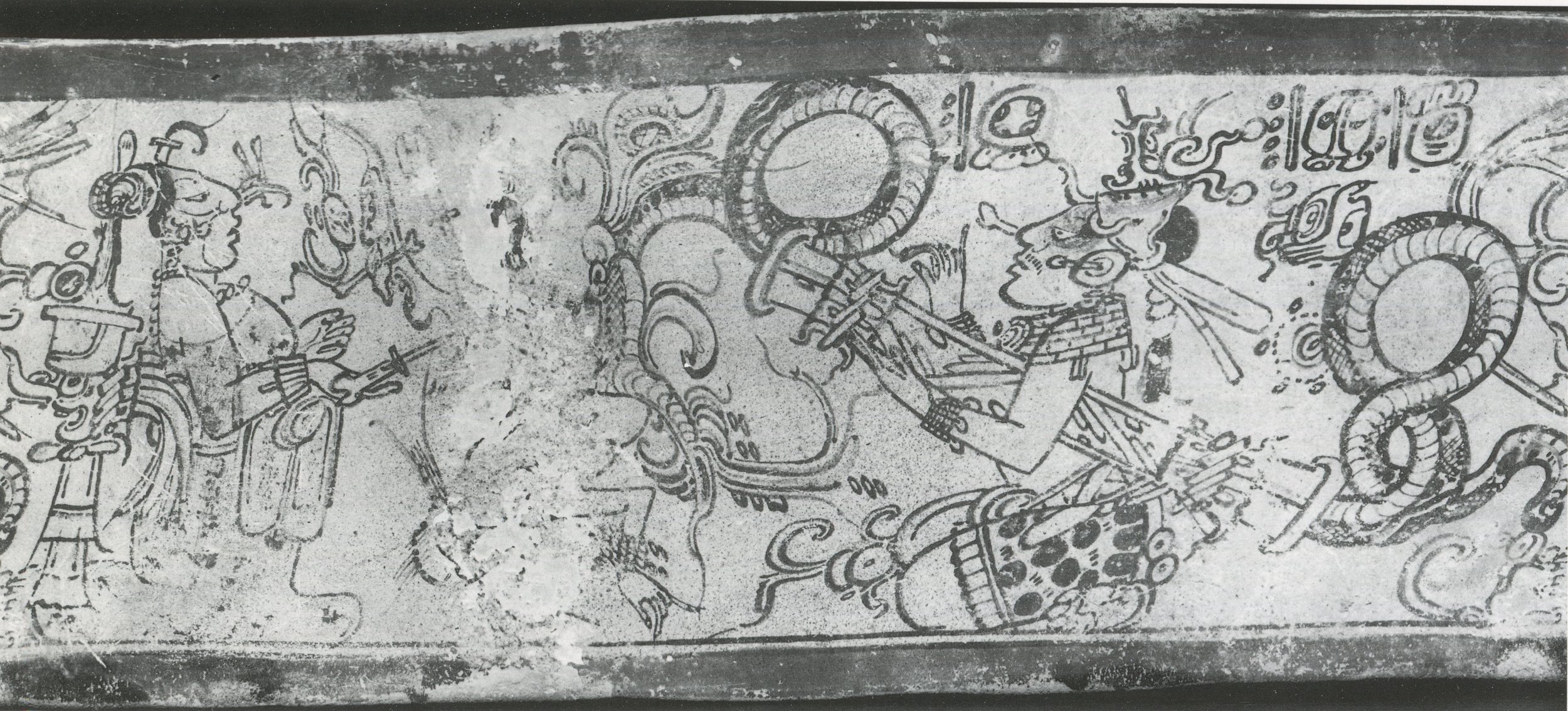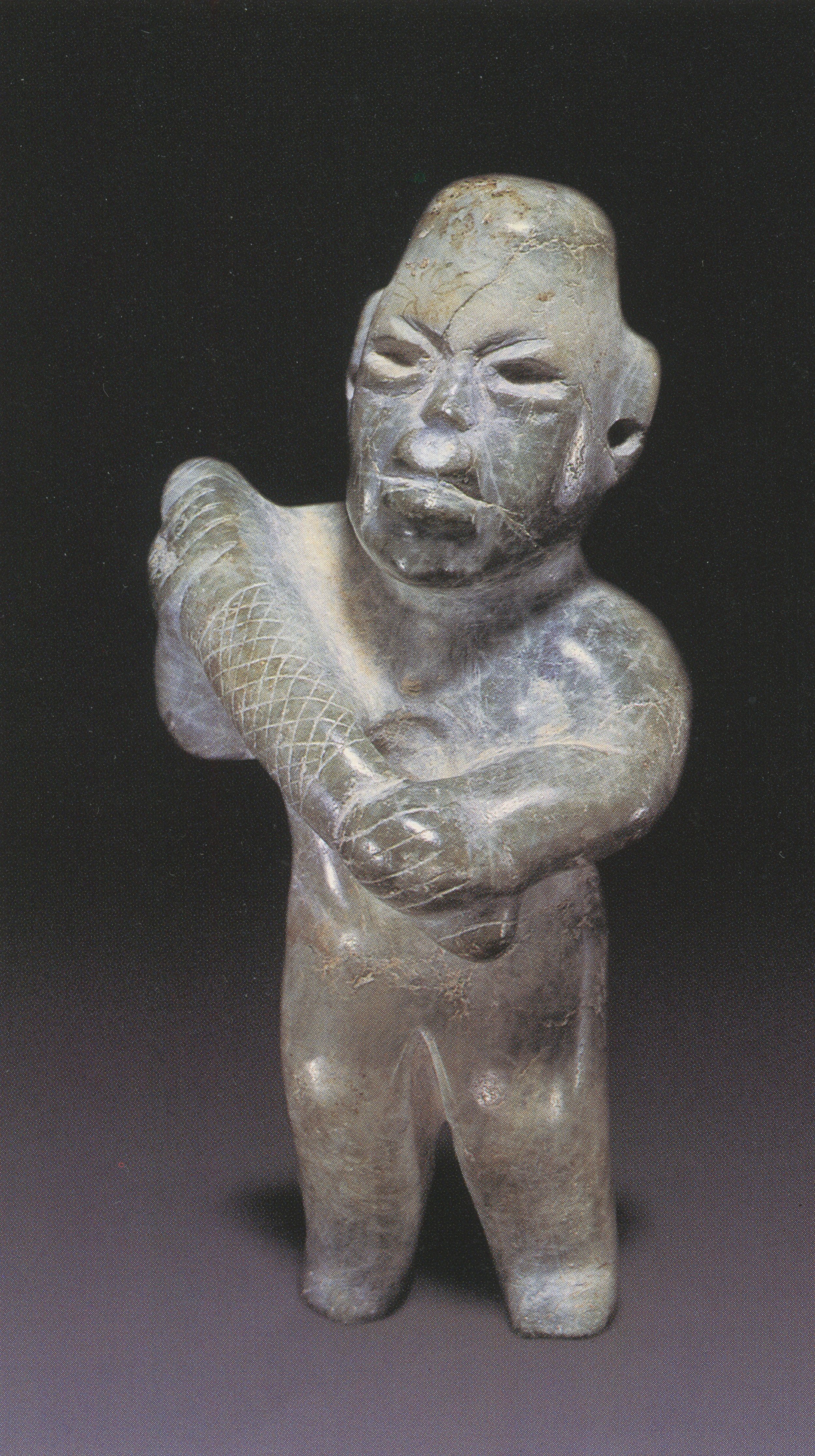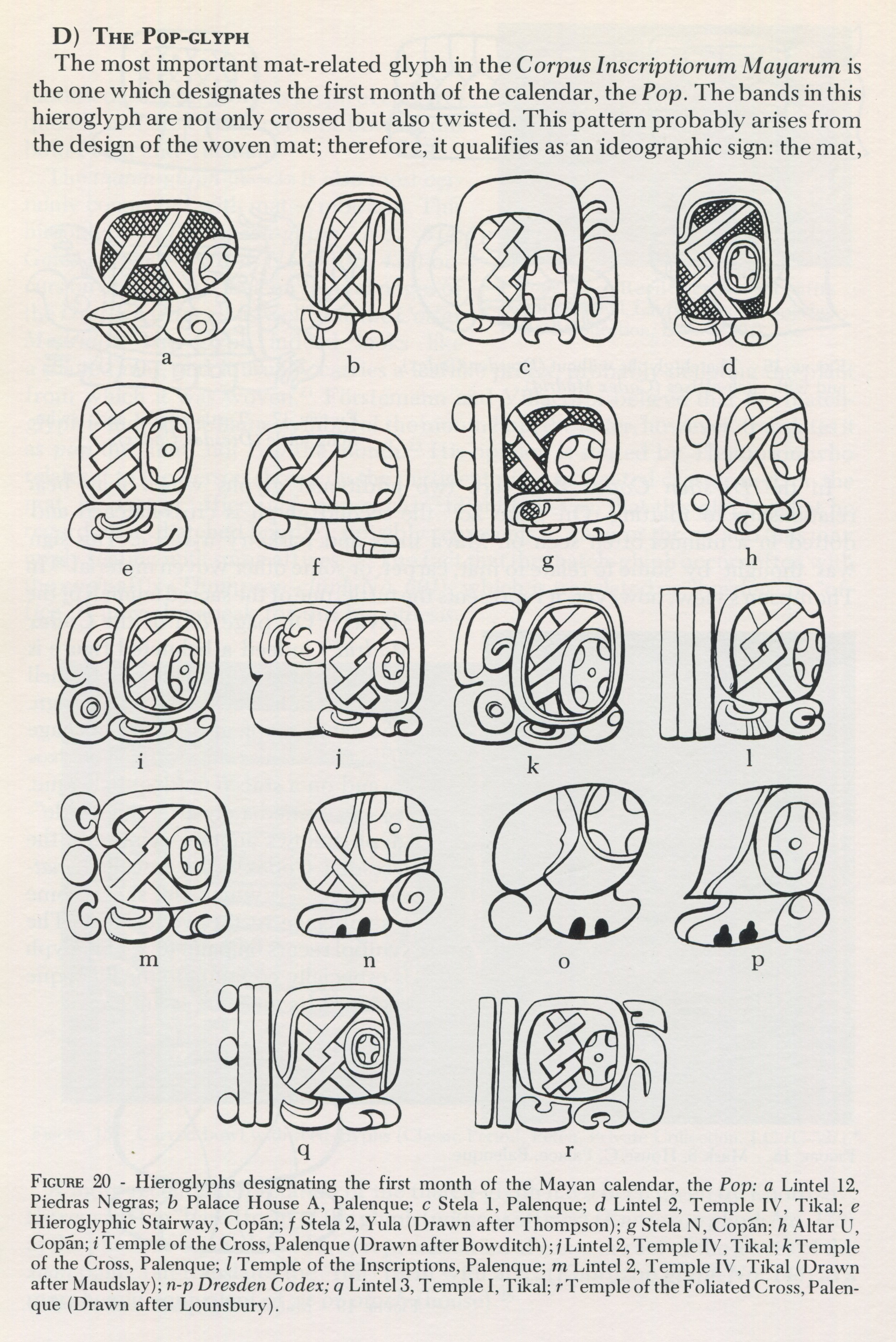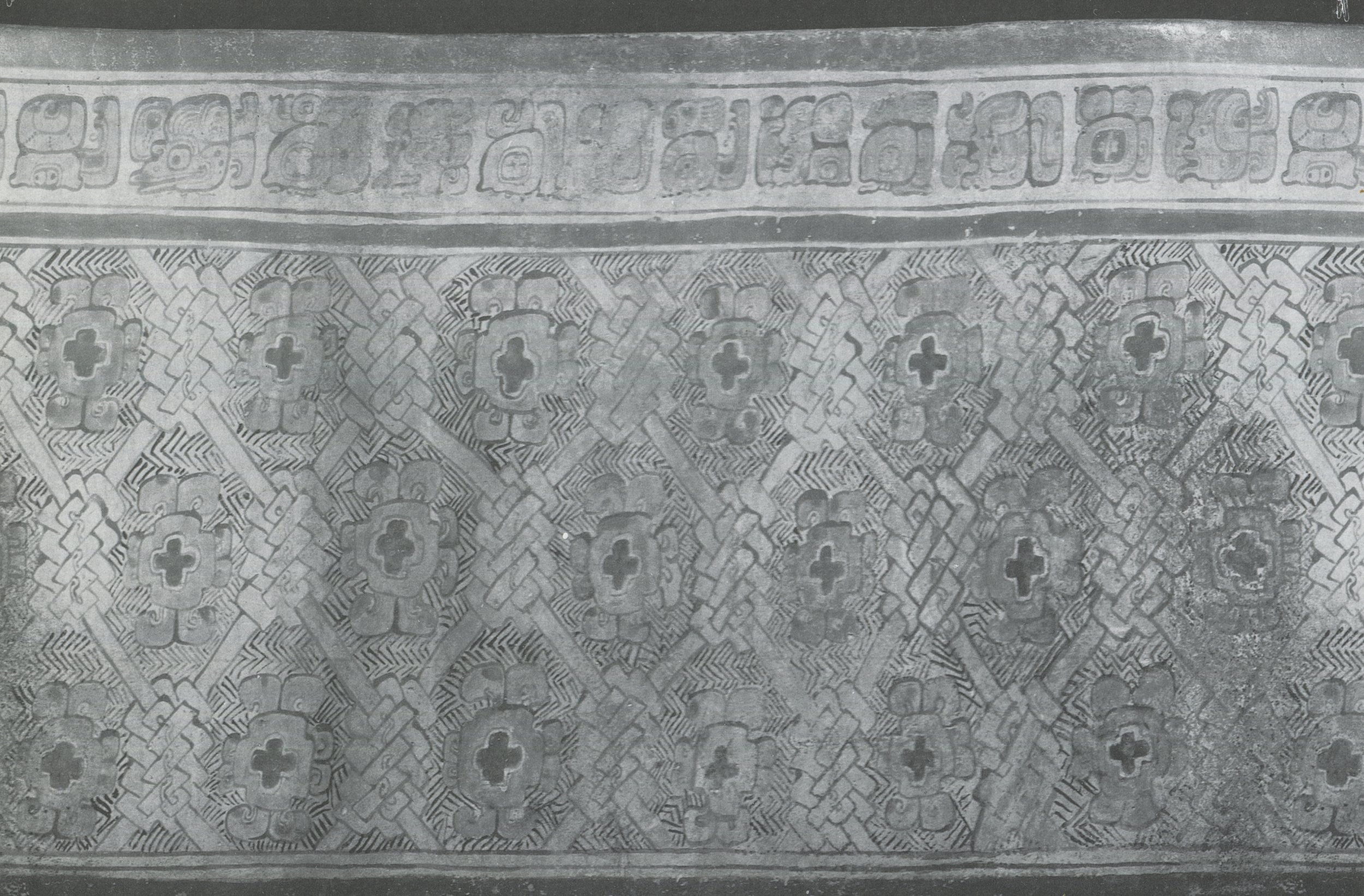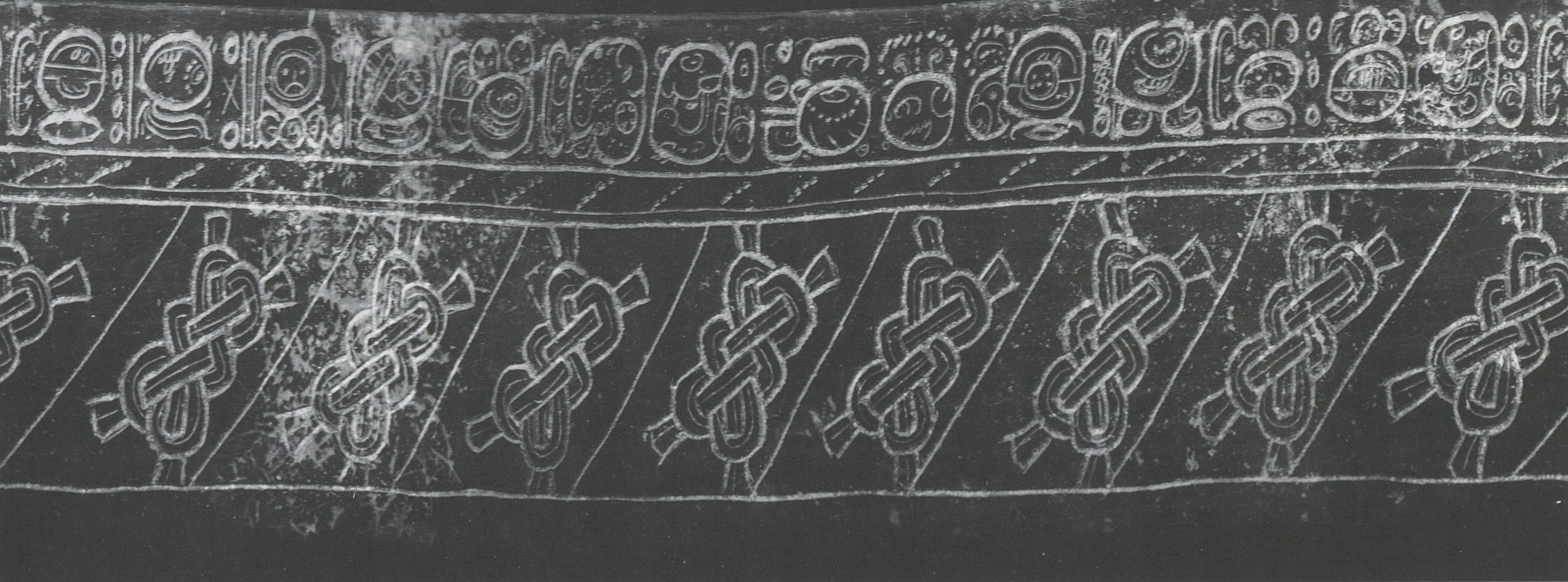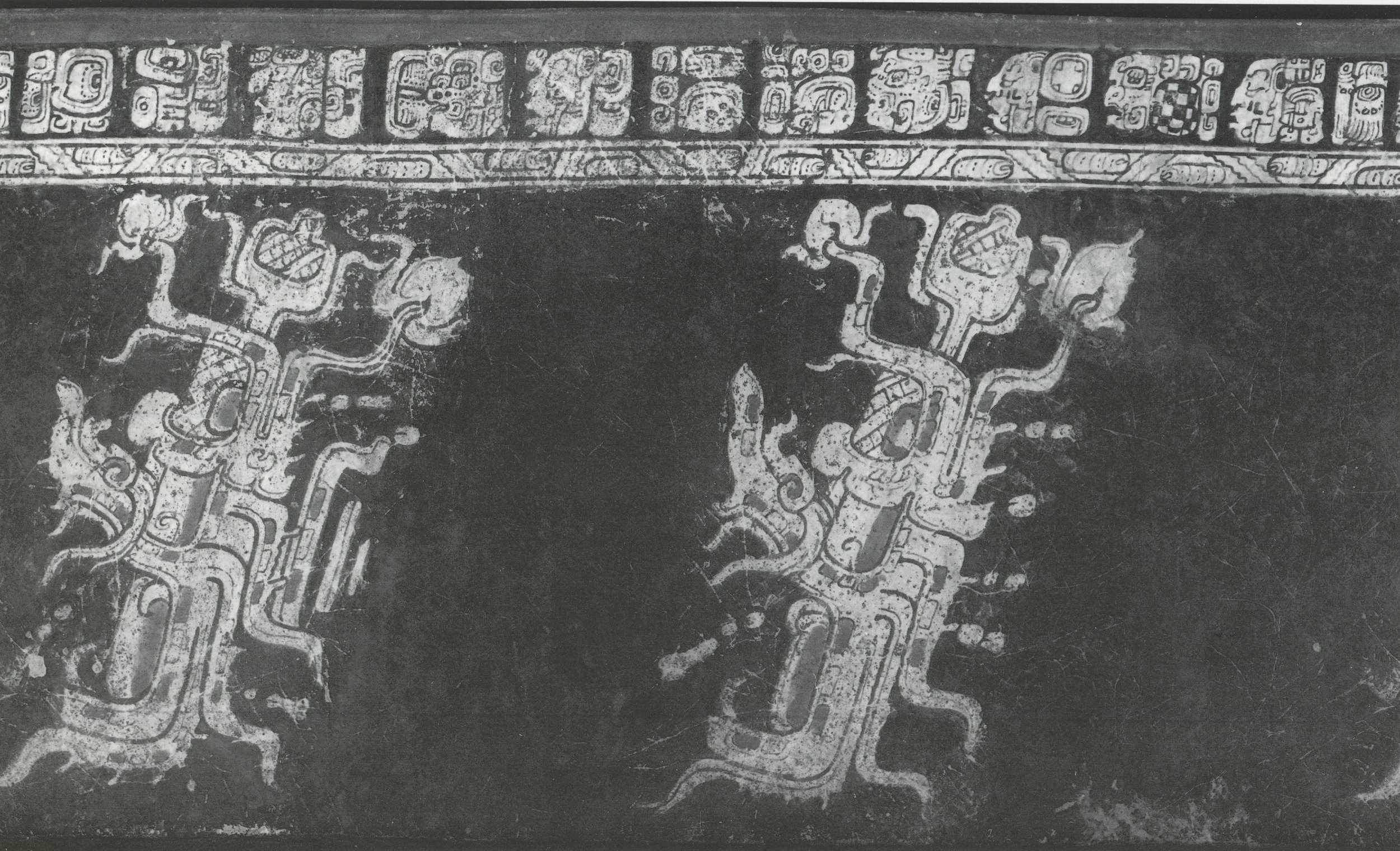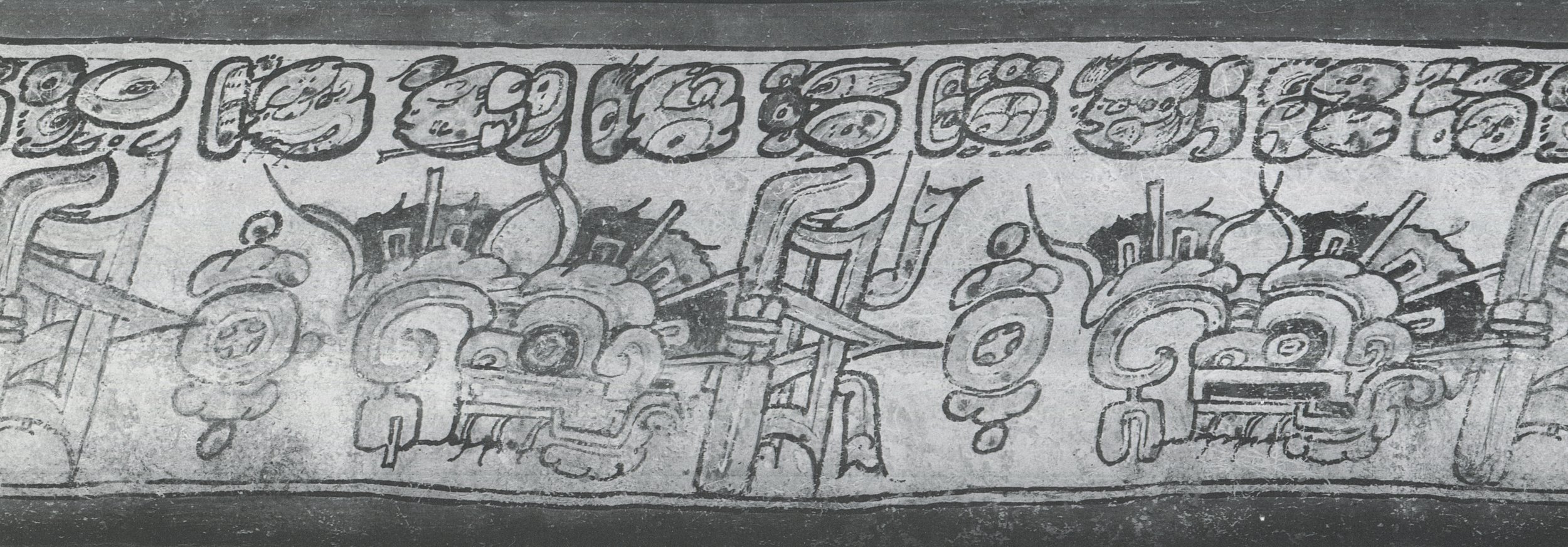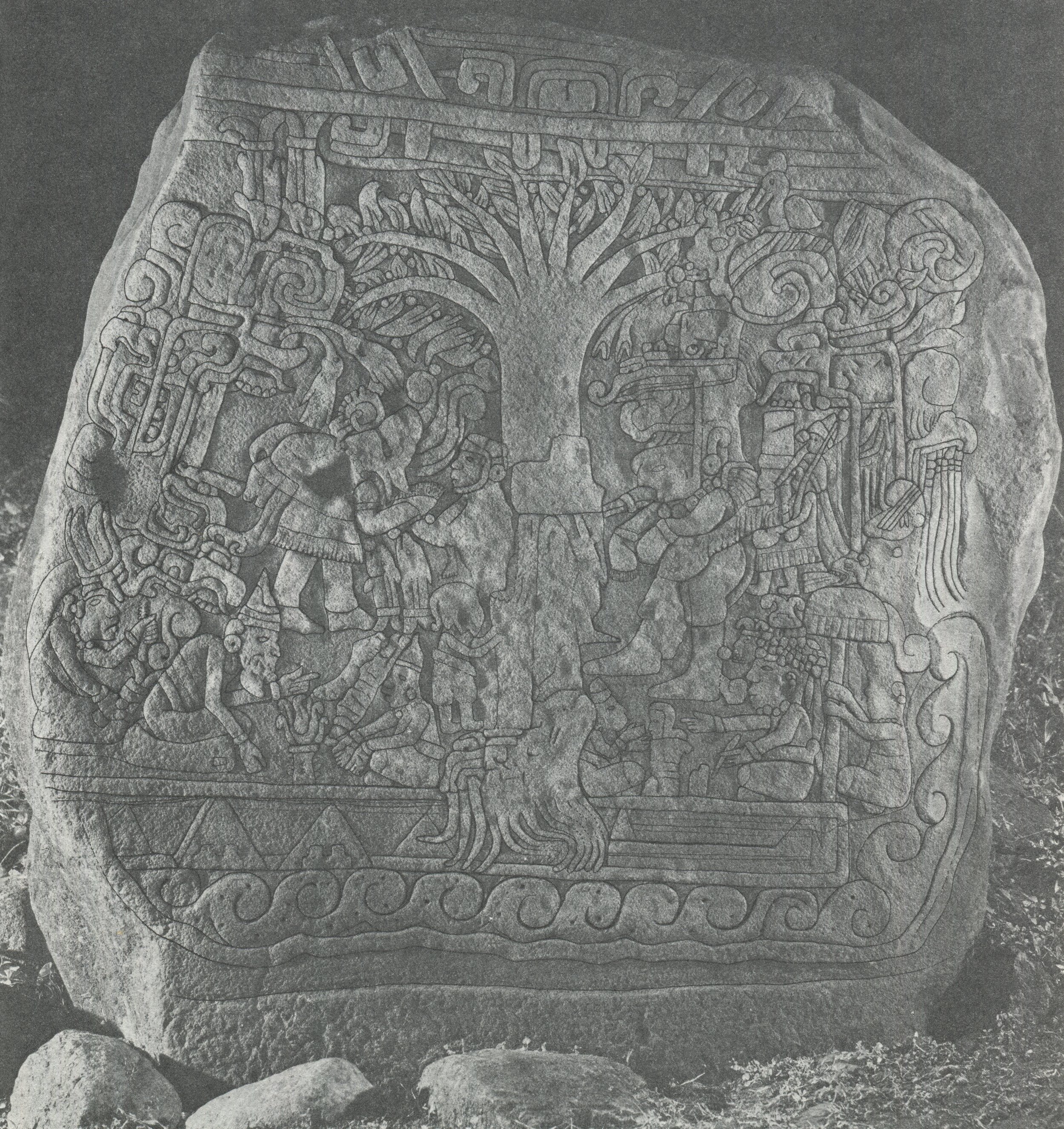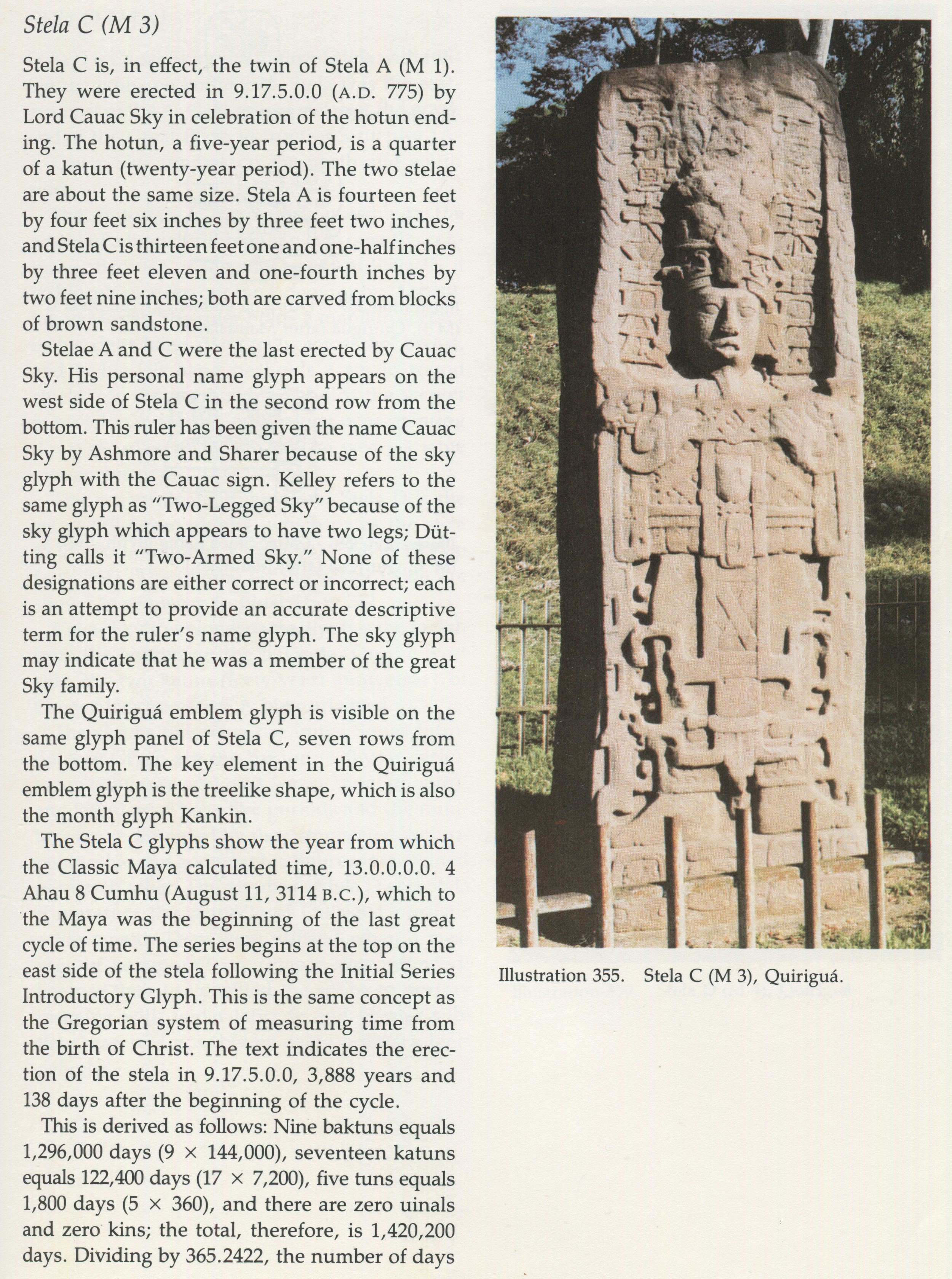
ART MOTIFS
Figures 22-39
Fig. 22 Mayan Net Dress Classic Maya c.500-750 CE
Fig. 23 Mayan Net Dress Classic Maya c. 500-750 CE
Fig. 22 Mayan Net Dress Classic Maya c.500-750 CE
Fig. 23 Mayan Net Dress Classic Maya c. 500-750 CE

Fig. 24 Queen Ix Yohl Ik’nal 583-604 CE
Fig. 25 Isis c. 1570-1293 BCE 18th Dynasty Egypt
Fig. 24 Queen Ix Yohl Ik’nal 583-604 CE
Queen Ix Yohl is facing to the left and wearing a beaded vertical-square net skirt. The slanted sides of the square, at right angles to each other and arranged ‘as above so below’, may be conflating the mat symbols into a single feminine or fertility motif that represents earth’s rotation on its tilted axis. See Fig.42.
Did Ix Yohl ascend to the throne in 583 due to a dynastic catastrophe that may have befallen Kiniche K’an B’alam I, the first king of Palenque to use the kiniche, ‘Great Sun’title? On August 11, 584 there was a total solar eclipse very close by with Palenque experiencing 80-90% totality. (NASA Five Millennium Canon of Solar Eclipses 2006) August 11, 3114 BCE is the founding date for the Long Count Calendar used at Palenque and depending on calendric correlation this was very close to or exactly the day of the Long Count founding day celebrations at Palenque. What a tragic coincidence especially if it came as a surprise that would likely have called into question not only Kan B’alam I’s authority and the right to use the kiniche title but also the dynasty’s legitimacy. Kan B’alam I who supposedly died February 1, 583 left no male heir and disappeared from the historical record. Queen Ix Yohl ascends to the throne in 583, ‘survives’ the solar eclipse apparently with no issues and reigns for another twenty years. Is this a cover up? Coincidentally there was a total solar eclipse at Palenque nineteen years earlier on February 16, 565 the same year K’an B’alam’s predecessor Ahkal Mo’ Naab II 565- 570 inherited the throne from K’an Joy Chitam I 529-565. Queen Ix Yohl went on to survive the attack on Palenque in 599 by Scroll Serpent 579-611of Calakamul only to end up negotiating the dynastic modification that saw K’an Mo Hix, from either Calakmul or Tonina, marry Lady Sak K’uk’ and conceive Pacal around 703, the year before Ix Yohl dies in 604. Scroll Serpent returned and attacked Palenque again in 611 ultimately dispensing with Aj Ne’ Ohl 605-612, Ix Yohl’s successor, and Janaab Pacal, a close relative, essentially eliminating any future dynastic challenge from that particular patriline. Kiniche Janaab Pacal ascends to the throne in 615. During Pacal’s sixty-eight year reign there were four different kings that came and went at Calakmul. It appears that the naming and particularly the ascension to the throne of Kiniche Janaaab Pacal so soon after Janaab Pacal’s demise and the naming of his son K’an B’alam II were an ‘authorized’ attempt at rehabilitating or reestablishing K’an B’alam I’s patriline something likely documented and cosmically legitimized on the Tablets of the Cross.
Palenque is located at a unique and fortuitous location that essentially functions as a chokepoint not only for trade moving north by land from the Peten but also any trade moving to or from Tonina and the Pacific coast. Pacal’s long reign appears to have accommodated some serious issues the elites of Calakmul and very likely Tonina as well may have had with Palenque and K’an Joy Chitam I whose long and apparently successful thirty six year reign from 529-565 was no doubt due in part to his ability to control these trade routes and set his own terms. Over time these terms likely became onerous and most probably caused considerable friction at the Usumacinta River crossings between Tuun K’ab’ Hix who ruled Calakmul from 520-546 and K’an Joy Chitam. Their reigns overlapped some seventeen years and it is an unlikely coincidence that one K’an Mo Hix married Pacal’s mother Sak K’uk thereby correcting or realigning Palenque’s patriline. Scroll Serpent also inherited a somewhat troubled patriline, one that appeared to be in something of a dynastic crises involving the two kings preceding him that followed Tuun K’ab’ Hix. Scroll Serpent 579-611 ruled Calakmul for thirty-two years, before, during, and after the near total solar eclipse at Palenque and all of Queen Ix Yohl’s reign. He conducted the two attacks on Palenque that ultimately resulted in the alteration of the ruling patriline. He arranged the marriage between Sak K’uk and K’an Mo’ Hix and watched Pacal grow to maturity before eliminating any direct challenge from the previous Palenque patriline. He then exits the stage sometime after 611 leaving Pacal to reign for sixty-eight long years at Palenque. He dies without leaving a surviving male heir that results in a succession crises at Calakmul, one lasting for around ten years. Curiously enough the name Hix also appears at Tonina. Kinich Hix Chapat 595-665 ruled before and during much of Pacal’s time on the throne. It is possible that Pacal’s father K’an Mo’Hix was from Tonina. According to Simon Martin and Nikolai Grube in their book ‘Chronicle of the Maya Kings and Queens’ the name Hix is very rare and known only to exist at Calakmul, Tonina, and Palenque, chronologically in that order. It appears that after fifteen years or so of Queen Ix Yohl’s reign the Hix’s at Tonina and the Hix descendants at Calakmul decided it was time to challenge Palenque’s dominance. K’inich Hix Chapat of Tonina ascends to the throne sometime around 595 just before Scroll Serpent’s first attack on Palenque in 599. Hix Chapat’s reign ends in 665 and Pacal’s father K’an Mo’ Hix dies in 642 giving both many decades to influence Pacal and Palenque’s trade policies. Who was Scroll Serpent and where did the Hix’s go?
Fig. 25 Isis c. 1570-1293 BCE 18th Dynasty Egypt
Isis is shown facing to the left and wearing a beaded vertical-square net skirt very similar to Queen Ix Yohl’s skirt in Fig.24. Beginning with Fig.27 is the idea that certain angled artistic elements or motifs symbolize the earth’s celestial equator and its tilted polar axis. Isis represents earth’s celestial equator, its rotation and axial tilt. Those segments of the square that slant down from left to right symbolize earth’s rotation with earth’s axial tilt symbolized by the square’s sides that tilt down from right to left. The conflation of the two seems to symbolize the symbiotic relationship between the two. The right-angled nature of the square motif seems to suggest a connection with the plane of the ecliptic with Isis possibly symbolizing fertility and its causal relationship with earth’s celestial mechanics. (See Fig.42.)

Fig. 26 Stela H c.725 CE Copan
Fig. 27 Maya Panel c.650-800 CE Dos Pilas
Fig. 26 Stela H c.725 CE Copan
Compare the net skirt on this stela with those in Fig.24, Fig.25, and Fig.27.
Fig. 27 Maya Panel c.650-800 CE Dos Pilas
This image is from Francis Robicsek’s book ‘A Study in Mayan Art and History: The Mat Symbol’. The mat symbol is associated with pop the first month of the solar year in the Yucatec Maya calendar. As per Portal Gematria Pt IV; pop 47/2 = 23.5 is very close to earth’s 23.4 degree axial tilt. The figure here is shown wearing a beaded diamond net skirt and holding what many anthropologists have labeled a ‘ceremonial bar’ which actually appears to be a tube with a spirit entity seen emerging from the top end. The bottom end of the tube was likely cut off in antiquity ritually killing the encoded narrative. The ceremonial tube is cradled with his right arm at a particular angle. It is decorated with the ‘bar’ motif, the mat symbol, displayed singly and in mixed groups. These slanted bar-mat motifs represent earth’s celestial equator and its axial tilt as discussed in Fig.25. The angle at which the ceremonial tube is held, and the various bar-mat symbols angled similarly, represents earth’s rotation with the other bar-mat motifs ‘tilted’ in the other direction symbolizing earth’s tilted polar axis. Displayed in his headdress is a band of five bars tilted in the axial tilt direction. This is in contrast to most of the bars on the ceremonial tube. His circular ear spool is shown with an extension slanting down at the celestial equator angle. All in all, several different cultural interpretations of earth’s celestial mechanics assembled together a certain way to legitimize this person’s right to rule.

Fig. 28 Maya Vase c. 650 CE (K2715)
Fig. 29 Maya Vase c. 650 CE (K2572)
Fig. 28 Maya Vase c. 650 CE (K2715)
The feathered serpent is seen entering and exiting a hollow ‘ceremonial tube’ that is held at the angle of the earth’s celestial equator. The angle of the tube is earth rotation dominant. It has two groups of three bars slanted in the axial tilt direction, one at each end of the tube with several more slanted elements angled in both directions just beneath the arm of the one holding the tube. If this image has anything to do with the Vernal Equinox, what is possibly being symbolically encoded depicts the earth’s horizon rotating into the sun’s ‘view’ while aligning earth’s axis to the plane of the ecliptic. (See Fig.27 and Fig.29)
Fig. 29 Maya Vase c. 650 CE (K2572)
The ceremonial tube displayed here is held in an axial tilt-centric angle. Though there are fewer looped coils of the feathered serpent entering and exiting the tube than in Fig.28, the overall similarity between the two vases seem to suggest the same event, most likely the Vernal Equinox, but from two different perspectives, earth’s rotation on its tilted polar axis, and the tilted polar axis itself and its relationship to the sun and the plane of the ecliptic on the Vernal Equinox. The bottom of the ceremonial tube is shown touching the ‘baseline’ that likely represents the plane of the ecliptic when both come into alignment on an equinox. (See Fig.27 and Fig.28)

Fig. 30 Olmec Statuette c.1200 BCE
Fig. 31 The Pop Glyph
Fig. 30 Olmec Statuette c.1200 BCE
The angle at which the bundle is being held, together with the net motif composed of two grids aligned at right angles to each other, suggests the encoding of the complimentary relationship between the earth’s rotation, symbolized by the grid slanting down from left to right, the celestial equator, and its tilted axis symbolized by the opposing grid of the net tilting down from right to left.
Fig. 31 The Pop Glyph

Fig. 32 Maya Vase c. 650 CE (K5179)
Fig. 33 Maya Vase c. 650 CE (K4732)
Fig. 32 Maya Vase c. 650 CE (K5179)
This diamond net motif is composed of both earth rotation and axial tilt elements intertwined with complex triple wrapped bar-mat motifs that appear to directly link the diamond net to earth’s celestial mechanics while emphasizing its axial tilt. The black cross in the center likely symbolizes a portal. See Fig.31.
Fig. 33 Maya Vase c. 650 CE (K4732)
This art motif slanted in the axial tilt-centric direction is composed of mat symbols woven and intertwined with rounded elements that likely symbolize earth’s rotation and its orbit around the sun and together with the vertical extensions top and bottom likely encode the axial tilt-centric moment earth’s celestial mechanics align with the sun on the Vernal Equinox.

Fig. 34 Maya Vase c. 650 CE (K1941)
Fig. 35 Maya Vase c. 650 CE (K4644)
Fig. 34 Maya Vase c. 650 CE (K1941)
This feathered serpent motif with cross-hatching and mat symbols is slanted in the axial tilt direction. The glyph top and center is the same as the one mentioned in Fig.35. Note the glyph with the tilted checkerboard motif, a motif I associate with the plane of the ecliptic when displayed horizontally. Shown here tilted at this angle suggests something that emphasizes a combination of earth’s orbital plane with its rotation, very likely during the Vernal Equinox. The cross hatching in both eyes exhibit an axial tilt emphasis as do the floral crosshatched motifs at the top both very much centered in between the outer two solstice motifs.
Fig. 35 Maya Vase c. 650 CE (K4644)
These uniquely stylized art motifs are slanted in the axial tilt direction and are interwoven with a square-like ‘v’ motif that may be mimicking the 23.4 degree ‘gap’ or ‘jaw’ between the plane of the ecliptic and earth’s celestial equator, the Vedic Golden Womb. (Fig.1) Note that both of these motifs point to a circular glyph or symbol. The one at the right nearly touches the edge of the circle, possibly the horizon, while the other clearly penetrates into the circle shown tilted in the axial tilt direction, possibly implying some sort of cosmic or celestially fertile moment in time just before, during, and after the Vernal Equinox.

Fig. 36 Stela 5 Izapa ca.150 BCE-150 CE
Fig. 37 Tonina
Fig. 36 Stela 5 Izapa ca.150 BCE-150 CE
The narrative on this stela describes how ‘The Light That Came From Across the Sea’ arrived in Xibalba. This likely involved some knowledge of celestial mechanics with the conspicuously slanted art motif at the left suggesting the role earth’s axial tilt plays in the journey’s narrative, possibly a reference to true north. See Figs.35&36. (See Izapa Stela 5; Part II Xibalba and the Road of the Gods)
Fig. 37 Tonina
This figure is facing to the left, possibly towards the west, and is shown holding a ‘ceremonial tube’ in a horizontal position. This ceremonial tube is very similar to the one in Fig.27 except the bar-mat motifs are reversed emphasizing earth’s axial tilt. He wears an ear-spool with an axial tilt angled extension that has an additional rotation angled bar and sphere at the bottom. The bird at the top with the hook in its eye represents the Pole Star, or Heart of Sky and its relationship to earth’s tilted axis. All of these motifs together most likely encode the celestial mechanics involved with equinox or zenith passage sunrises or sunsets and shown here display this person’s right to rule.

Fig. 38 Maya Statue/Copan
Fig. 39 Hasaw Chan K’awil c.700 CE Tikal
Fig. 38 Maya Statue/Copan
Net skirt motif together with a horizontal ceremonial tube. Note the dating in the last two paragraphs. “The text indicates the erection of the stela in 9.17.5.0.0, 3,888 years..”. (3,888/3 = 1,296) “This is derived as follows: Nine baktuns equals 1,296,000 days (9x144)…” Enshrined in some myths is the 25,920 (12x2160) year cycle of the Precession of the Equinoxes. Dividing this number by 2,000 = 1.296 or by converting 25,920 to 2.5920 and following the Portal Gematria mathematics we have 4/2.5920 = (2/)1.5432098 = 1.296. Is the Long Count calendar possibly related to the Precession of the Equinoxes?
Fig. 39 Hasaw Chan K’awil c.700 CE Tikal
Hasaw Chan K’awil is holding a ceremonial bar adorned with a pair of vertical- square symbols. The vertical-square motif shown here in association with the ceremonial bar held horizontally likely encodes something similar to the ceremonial tube held horizontally in Fig.37 with the double axial-tilt bar-mat motif decorating the ceremonial tube also seen being worn by Hasaw Chan K’awil. He wears both an ear-spool with an attachment at the axial tilt angle and an ear-spool in his headdress with an attachment angled at the earth rotation angle. The bar-mat motif with the double axial-tilt bars over a single rotation bar that he wears on his belt likely represents and emphasizes earth’s axial tilt in the narrative. All together these motifs seem to symbolize not just the knowledge of celestial mechanics but very likely a specific event, the Vernal Equinox. The two vertical squares symbolize earth’s celestial equator and axial tilt with the horizontal bar symbolizing earth’s orbit around the sun, the plane of the ecliptic. (See Fig.42)
